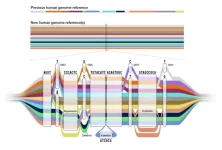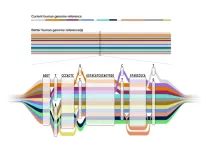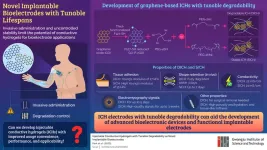EMBARGOED UNTIL WEDNESDAY, MAY 10, 2023, AT 11AM ET
New York, NY (May 10, 2023)—Eimear Kenny, PhD, had just completed undergrad and was working in her first computational genomics job more than 20 years ago when scientists announced the first (nearly) complete sequencing of the human genome—what was considered at the time to be the fundamental blueprint for all humans. The Human Genome Project aimed to map the entire genome in an effort to accelerate the diagnosis and eventual treatment of common and rare diseases.
Now, Dr. Kenny, a Professor of Medicine, and Genetics and Genomic Sciences, at the Icahn School of Medicine at Mount Sinai, can count herself as one of a handful of elite scientists worldwide whose vital contributions have led to the creation of the new human “pangenome” reference, a collection of genome sequences that captures significantly more human diversity.
Details on these novel developments were described in several Nature papers published Wednesday, May 10. The work was led by the international Human Pangenome Reference Consortium, a group funded by the National Human Genome Research Institute (NHGRI), part of the National Institutes of Health. Dr. Kenny is a Principal Investigator and lead scientist of the consortium.
Titles/DOI’s/Url’s of the six Nature papers are as follows:
Liao et al. A draft human pangenome reference. Nature. Doi: 10.1038/s41586-023-05896-x (2023).
Vollger et al. Increased mutation rate and gene conversion within human segmental duplications. Nature. Doi: 10.1038/s41586-023-05895-y (2023).
Guarracino et al. Recombination between heterologous human acrocentric chromosomes. Nature. Doi: 10.1038/s41586-023-05976-y (2023).
Hickey et al. Pangenome graph construction from genome alignment with minigraph-cactus. Nature Biotechnology. Doi: 10.1038/s41587-023-01793-w (2023).
A genome is the set of DNA instructions that helps each living creature develop and function. Genome sequences differ slightly among individuals. In the case of humans, any two peoples’ genomes are, on average, more than 99 percent identical. The small differences contribute to each person’s uniqueness and can provide insights about their health, helping to diagnose disease, predict outcomes and guide medical treatments.
“We have had a single human reference for the past 20 years, and this genome reference has been extraordinarily powerful. It is a resource that has driven the sequencing of the genomes of tens or hundreds of millions of humans on the planet,” says Dr. Kenny, Professor of Medicine, and Genetics and Genomics Sciences at the Icahn School of Medicine at Mount Sinai, who is a co-author of the work. “However, it is limited in that most of the reference sequence only represents one person on the planet, so when you have rarer sequences or only in certain people, they are not represented. Therefore, we needed to really think about how to update the human reference and make it much more representative of diverse humans all over the world, which is what we have now done.”
The new pangenome reference includes genome sequences of 47 people, and the researchers aim to increase that number to 350 by mid-2024. Because each person carries a paired set of chromosomes, the current reference includes 94 distinct genome sequences, with a goal of reaching 700 distinct genome sequences by the completion of the project.
“Basic researchers and clinicians who use genomics need access to a reference sequence that reflects the remarkable diversity of the human population. This will help make the reference useful for all people, thereby helping to reduce the chances of propagating health disparities,” says Eric Green, MD, PhD, NHGRI director. “Creating and enhancing a human pangenome reference aligns with NHGRI’s goal of striving for global diversity in all aspects of genomics research, which is crucial to advance genomic knowledge and implement genomic medicine in an equitable way.”
Dr. Kenny, who is also Founding Director of the Institute for Genomic Health at Icahn Mount Sinai, leads research at the interface of genomics, medicine, and computer science to accelerate the use of genomics information in routine clinical care to improve human health.
She uses machine learning approaches and massive-scale databases of genomic information for discovery of novel genetic variants impacting disease risk. She also oversees large clinical trials in on implementing genomic medicine in diverse populations.
That expertise has paid off.
“Across many individuals, my role in this consortium was to contribute to this international scientific effort, and, in particular, help select the genomes that make up the new pangenome reference so that this resource would best benefit many people around the planet” she says.
Dr. Kenny co-led a team using population genetics approaches, community engagement, and outreach to include genomes from diverse populations in the pangenome. This will help address issues of underrepresentation and bias in genomics research, and can improve the accuracy and generalizability of research findings across different populations.
The Human Genome Project completed in 2003 covered about 92 percent of the total human genome sequence. Recent technological advances such as long-read DNA sequencing, which reads longer stretches of the DNA at a time, helped researchers fill in those gaps to create the first complete human genome sequence. The developments were reported in a set of six papers in the April 1, 2022, issue of Science, along with companion papers published in several other journals. These findings were incorporated into the current pangenome reference.
“I’m delighted about the advancements in genomics technology that we have today. This new era of long-read sequencing, along with other capabilities, allows us to get much higher resolution of genomic sequences and, in particular, more accurately identify larger genomic variants called structural variants, which have been until now very difficult to detect with the short-read technology. This has enabled us to accelerate the rate at which we can find medically relevant variants and dramatically reduce sequencing costs,” says Dr. Kenny.
Importantly, knowing these variants better, Dr. Kenny says, will help elucidate which genes are truly rare or whether they may just be more common in certain parts of the world.
“The other significant aspect is that we are really trying to make a resource that is truly working toward global representativeness. We need to have a path toward recognizing that humans everywhere on the planet need resources available to them that best work for them,” says Dr. Kenny.
Institutions involved in the Human Pangenome Reference Consortium may be found on the project’s main page.
See video interview with Eimear Kenny, PhD.
See press release issued by the National Human Genome Research Institute (NHGRI) of the National Institutes of Health: https://www.genome.gov/news/news-release/scientists-release-a-new-human-pangenome-reference
-####-
About the Icahn School of Medicine at Mount Sinai
The Icahn School of Medicine at Mount Sinai is internationally renowned for its outstanding research, educational, and clinical care programs. It is the sole academic partner for the eight- member hospitals* of the Mount Sinai Health System, one of the largest academic health systems in the United States, providing care to a large and diverse patient population.
Ranked 14th nationwide in National Institutes of Health (NIH) funding and among the 99th percentile in research dollars per investigator according to the Association of American Medical Colleges, Icahn Mount Sinai has a talented, productive, and successful faculty. More than 3,000 full-time scientists, educators, and clinicians work within and across 34 academic departments and 35 multidisciplinary institutes, a structure that facilitates tremendous collaboration and synergy. Our emphasis on translational research and therapeutics is evident in such diverse areas as genomics/big data, virology, neuroscience, cardiology, geriatrics, as well as gastrointestinal and liver diseases.
Icahn Mount Sinai offers highly competitive MD, PhD, and Master’s degree programs, with current enrollment of approximately 1,300 students. It has the largest graduate medical education program in the country, with more than 2,000 clinical residents and fellows training throughout the Health System. In addition, more than 550 postdoctoral research fellows are in training within the Health System.
A culture of innovation and discovery permeates every Icahn Mount Sinai program. Mount Sinai’s technology transfer office, one of the largest in the country, partners with faculty and trainees to pursue optimal commercialization of intellectual property to ensure that Mount Sinai discoveries and innovations translate into healthcare products and services that benefit the public.
Icahn Mount Sinai’s commitment to breakthrough science and clinical care is enhanced by academic affiliations that supplement and complement the School’s programs.
Through the Mount Sinai Innovation Partners (MSIP), the Health System facilitates the real-world application and commercialization of medical breakthroughs made at Mount Sinai. Additionally, MSIP develops research partnerships with industry leaders such as Merck & Co., AstraZeneca, Novo Nordisk, and others.
The Icahn School of Medicine at Mount Sinai is located in New York City on the border between the Upper East Side and East Harlem, and classroom teaching takes place on a campus facing Central Park. Icahn Mount Sinai’s location offers many opportunities to interact with and care for diverse communities. Learning extends well beyond the borders of our physical campus, to the eight hospitals of the Mount Sinai Health System, our academic affiliates, and globally.
-------------------------------------------------------
* Mount Sinai Health System member hospitals: The Mount Sinai Hospital; Mount Sinai Beth Israel; Mount Sinai Brooklyn; Mount Sinai Morningside; Mount Sinai Queens; Mount Sinai South Nassau; Mount Sinai West; and New York Eye and Ear Infirmary of Mount Sinai.
END






